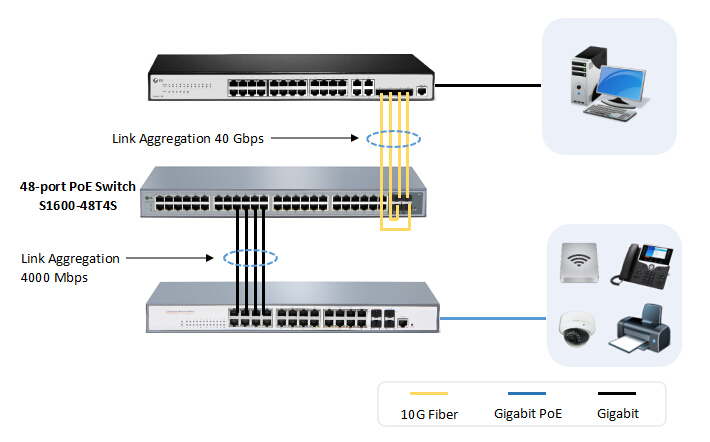It is generally known that Power over Ethernet (PoE) technology is developed to satisfy the needs of connectivity to network devices like IP cameras, VoIP phones and Wireless Access Points (WAP). As a consequence, power over Ethernet switch or PoE switch is required to be capable of supporting PoE devices. There are 8 port, 24 port and 48 port PoE Gigabit switches in the market. And for each type, managed PoE switch and unmanaged PoE switch are available. 8 port and 24 port PoE switches have been explained in previous posts. So today’s topic is about 48 port managed PoE switch vs 48 port unmanaged PoE switch.
48 Port PoE Switch: Why Choosing Managed Over Unmanaged?
48 port managed PoE switch can expand the long-range flexibility of your network and adapt to changing environments. With organization grows, your business needs will continue to increase. So it is wise to deploy 48 port managed PoE Gigabit switch which can respond to your dynamic business demands.
- 48 port PoE managed switch can be configured and it can prioritize LAN traffic to make the most important data get through. While 48 port PoE network switch unmanaged is a plug and play device which can not be configured or analyze the data traffic.
- If there is an unused port on 48 port managed PoE switch, you can disable that port or even employ MAC address filtering so as not to allow unauthorised users or devices to access the network by plugging in. This can ensure safe network connections.
- The major advantage of 48 port managed PoE switch is the failover redundancy which helps to achieve less network downtime.
Applications of 48 Port Managed PoE Switch
48 port managed PoE switch can be used in different networks as an access layer switch or a core switch.
- Deploying the 48 Port Managed PoE Switch in Access Layer
When used in access layer, the 48 port PoE switch can support multiple PoE network devices. Suppose that SMB has two office buildings located 100 meters from each other, and each building has a server rack. The first office has 20 VoIP phones, 10 IP cameras, 10 IP access points and 40 computers, while the another building has double the number of devices. Now we will need not only 48 port PoE switch but also 48 port Ethernet switch in the access layer.
Figure1: Deploying the 48 port PoE managed switch FS S1600-48T4S in access layer
- Deploying the 48 Port PoE Switch as a Core Switch
For small and midsize networks, the 48 port PoE Gigabit switch can also be used in the core area. It is workable to establish an aggregated high bandwidth link between core switch and access switch by implementing link aggregation. For a 48 port PoE switch with 10G fiber ports, it can not only realize 4x10G aggregation between core switch and access switch with 10G fiber uplink ports, but also achieve 4x1000Mbps aggregation between core switch and Gigabit access switch.
Figure2: Deploying the 48 port PoE switch FS S1600-48T4S as a core switch
Conclusion
As previously mentioned, we have discussed the reasons why choosing managed over unmanaged for 48 port PoE switch. Since a 48 port managed switch has more advantages than an unmanaged switch, it is better for you to have a managed switch in your network. 48 port managed PoE switch is preferred in LAN applications for both access layer and core layer because of its high functionality and simplified management features. If you have any demand, Fiberstore could meet your expectations.
Related Article: FS 24 Port PoE Switch Introduction

